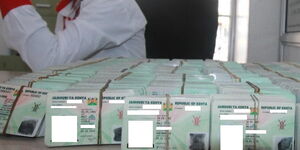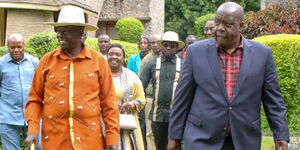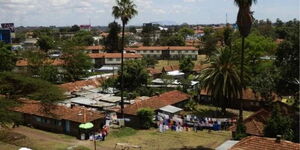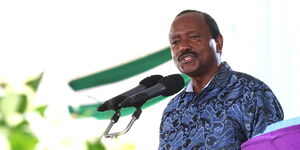After the launch of the new currency in Kenya by president Uhuru Kenyatta at the Narok stadium on Saturday we look back at the history of money in Kenya and its evolution.
Early use of currency in Kenya commenced with the Arab influence who were among the first to use currency as we know it.
In Muscat, they used a silver coin called the Maria Theresa Thaler (MT$), first minted in Austria in 1741 and, not surprisingly, they continued using it when the Sultanate moved to Zanzibar in 1832.
Around the same period, the silver rupee minted by the British East India Company (1600-1858) was increasingly being used along the Indian Ocean coast as the monsoon-dependent dhow trade with India expanded.
The British chartered company, the Imperial British East Africa Company (IBEA), got the concession to trade in the area referred to as Kenya today. They then issued the Pice, Rupees and Annas as the currency of the region.
After IBEA went bankrupt a single coin, the copper Pice was minted and was the only piece of currency to bear the name East Africa Protectorate and unlike the Imperial British East Africa (IBEA) coinage which used Latin on the face.
Penetration of coins and notes only started when construction of the railway commenced in Mombasa in May 1896, to reach Port Florence – present day Kisumu – in December 1901.
After world war one a decision was made in 1919 to replace the Mombasa Currency Board with a London based East African Currency Board (EACB) which would cater for the existing Protectorates as well as the newly acquired responsibility of providing currency to the Tanganyika Trust Territory.
The newly established EACB introduced an intermediate currency based on the English Florin with the thought that it would ease the transformation from Rupee to Shilling.
This then became the advent of the shilling in Kenya.
The shilling was however interchangeably used with the pound at a rate of twenty shillings to the pound and eventually only shillings and cents were used to independence.
As the East African territories became independent in sequence from 1962 the EACB ceased to issue notes with the image of the monarch and removed her name from the coinage.
For the banknotes, the interim currency was commonly known as the “Lake Issue” currency because of the background of Lake Victoria on the notes.
The Lake Victoria designed notes were in the denominations of 5,10, 20 and 100 shillings.
Kenya began printing and minting its own currency under the mandate given to the Central Bank of Kenya in the Central Bank of Kenya Act cap 491.
Banknotes for the Central Bank of Kenya, although not yet issued, were legalised under Legal Notice number 252 of 1966 dated July 1, 1966. Coins were issued in April 1967. EACB banknotes ceased to be legal tender in September 1967 while the EACB coins were demonetised in April 1969.
The initial issue of Kenya shilling notes were in the denominations of Ksh 5, Ksh 10, Ksh 20, Ksh 50 and Ksh 100, all bearing the portrait of the first President of Kenya, Mzee Jomo Kenyatta, in the front, and diverse scenes of economic activities in Kenya at the back. These notes were the first using the double title of Banki Kuu ya Kenya and Central Bank of Kenya.
On April 10, 1967, new Kenya shilling coins were issued in the denominations of 5 cents, 10 cents, 25 cents, 50 cents and Ksh 1.
The coins were minted by the Royal Mint of U.K. and made from cupro-nickel. Like the notes, the obverse featured the portrait of Kenya’s founding father, Mzee Jomo Kenyatta.
The reverse, however, featured the Kenyan coat of arms, a theme that has remained a dominant feature to the present series of coins.
To mark some national and central banking events, the Central Bank of Kenya has and continues to issue special commemorative currencies.
These special currencies are limited in number and are specifically printed or minted to celebrate an event or in honour of a person.
They form a historical reference point and memento for the country.
Due to their specialty and use of precious materials like gold or silver, these currencies become very unique attracting demand from numismatic collectors or other individuals.
In 1980, a portrait of Daniel Arap Moi replaced Kenyatta until 2005, when the central bank introduced a new coin series that restored the portrait of Kenyatta. The coins are 50 cents and Ksh 1 in stainless steel and bi-metallic of Ksh 5, Ksh 10 and Ksh 20.
Ksh 5 notes were replaced by coins in 1985, with the same happening to Ksh 10 and Ksh 20 in 1994 and 1998. In 1986, Ksh 200 notes were introduced, followed by Ksh 500 in 1988 and Ksh 1000 in 1994.
The banknotes are printed in Nairobi by British security printer De La Rue.
On December 11, 2018, Central Bank governor Patrick Njoroge and President Uhuru Kenyatta launched the new generation coins that were in line with the 2010 constitution of the Republic of Kenya dropping the images of the former presidents and embracing wildlife.
They launched the Ksh 1, Ksh 5, Ksh 10 and Ksh 20 coins.
The new generation notes to replace the ones with presidential photos were launched on June 1, 2019, at the Narok stadium by the duo also abolishing the old Ksh 1000 notes.
Denominations of the launched currencies were between Ksh 50 and Ksh 1000.












